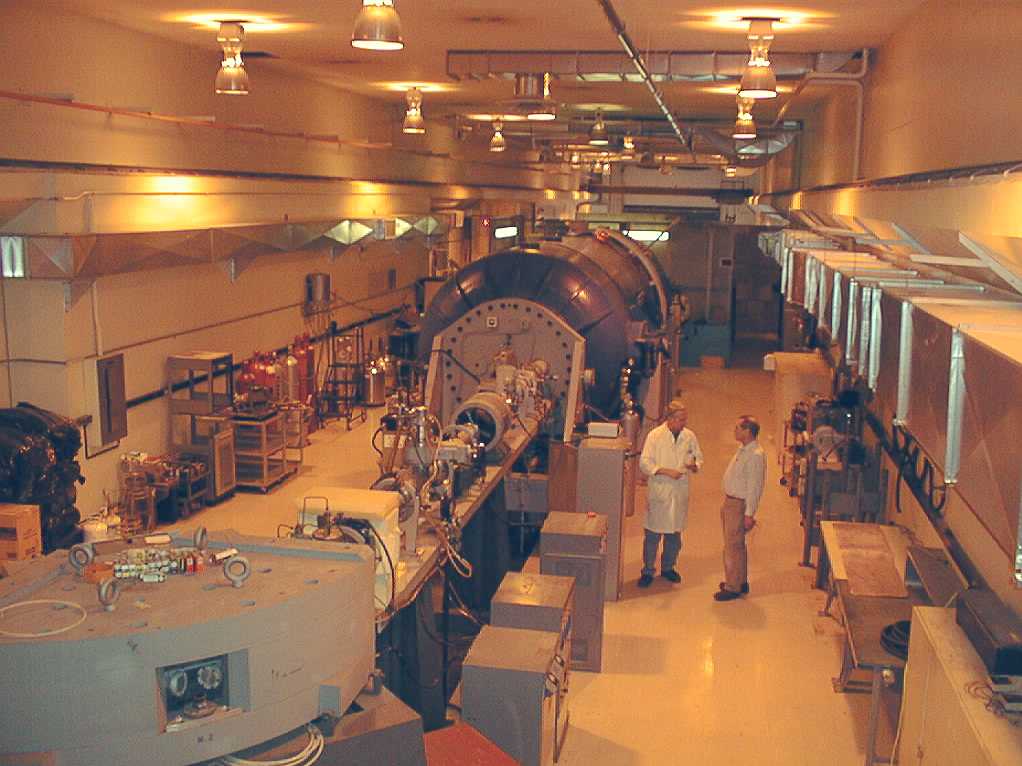SjoerdRoorda
⚠ (:searchbox size=13 label=Go value=Search focus=true:)
Research infrastructure
Filed in: Roorda.Infrastructure · Modified on : Tue, 04 Mar 14
The ion beam laboratory at the Université de Montréal campus houses two Tandem accelerators. See the description below for details on the associated beamlines. See also : http://www.lps.umontreal.ca/ion/index.html
1.7 MV Tandetron
Louis Godbout adjusts slits on 1.7 MV Tandetron (photo F. Busque)
The 1.7 MV Tandetron (pictured on the right) provides ion beams from 0.2 to 5 MeV, often He ions (for RBS or channeling) or any other ion (except the other noble gases) for ion implantation. There is a recirculating gas stripper for high throughput. The following two beam lines are active:
- -30 degrees: a beam line for ion beam analysis. Two sets of slits (adjustable, just behind the magnet, and fixed, at the entrance of the chamber) assure a low-divergence ion beam for Rutherford Backscattering Spectrometry (RBS), channeling and Elastic Recoil Detection (ERD). Three surface barrier detectors are mounted : one for regular RBS, one for glancing angle RBS with improved depth resolution, and one for ERD. The ERD detector requires a stopper foil.
- +15 degrees: a beam line for ion implantation. An electrostatic raster scanner followed by a deflection through a few degrees assures that only a well raster scanned beam hits the target. The target chamber consists of three elements. First, a replaceable square aperture which defines the irradiated area. Apertures from 0.5 to 0.5 cm2 to 2x2 inch2 can be mounted. Second, the target holder is a 2x2x4 inch Cu block which can be heated (to 300 C), cooled (filled with liquid nitrogen), rotated, or displaced vertically. Large windows allow the user to inspect the sample during implantation. The third element is a Faraday cup, used to measure the ion beam current.
6 MV Tandem

Pierre Bérichon and John Brebner amble about the 6 MV Tandem
The 6MV Tandem is in fact the first Tandem accelerator ever built, and has the serial number EN-1. (See this large file for the interesting history of electrostatic accelerators.) Several original parts have been replaced: the injector with two ion sources is a modern HVEE 90 degrees injector. The van de Graaf charging belt has been replaced by a pelletron system from NEC. The accelerator tubes have been replaced by modern inclined-field tubes and there is a custom built gas recirculating stripper. The 90 degrees analysis magnet is stabilized by an NMR system and a switching magnet steers the beam into any one of the following beam lines:
- -30 degrees : Thin film activation. The beam passes through a fast acting valve (only closes in an emergency) into a beam line housed in a neutron shielding shed. At the end of the beam line, the ions pass through a thin Al foil into the air. This line is used by ANS Technologies for ultra-sensitive wear studies.
- -15 degrees : Elastic recoil detection (ERD) with dE/E gas ionization counters. By measuring both dE and Etot, for each individual forward scattered recoil, one can determine its mass. The total energy spectrum, mass separated, can then be used to extract a depth profile. The advantage of a dE/E system is its very high solid angle but it comes at the price of a reduced depth resolution.
- 0 degrees: A triple-purpose beam line. The first chamber is used for RBS (in case the Tandetron is not available), the next station allows a small number of ions to be deflected into a detector-testing setup used for the calibration and anlysis of Medipix and Timepix position sensitive particle detectors. (These detectors are developed for particle physics applications.) The end of the beam line has a rotating beam-stop holder which, when equipped with a thin Li foil, can act as a neutron source. The energy of the neutrons thus produced can be controlled and the resulting mono-energetic neutron beams can be used to test detectors for research into dark matter.
- +15 degrees: A beam line for hydrogen profiling by N-15 resonance.
- +30 degrees. A beam line for ion implantation (nearly the same description as the implantation line at the Tandetron). An electrostatic raster scanner assures that only a well raster scanned beam hits the target. The target chamber consists three elements. First, a replaceable square aperture which defines the irradiated area. Apertures from 0.5 to 0.5 cm2 to 2x2 inch2 can be mounted. Second, the target holder is a 2x2x4 inch Cu block which can be heated (to 300 C), cooled (filled with liquid nitrogen), rotated, or displaced vertically. Large windows allows the user to inspect the sample during implantation. The third element is a Faraday cup, used to measure the ion beam current.
- +45 degrees. A beam line used for ERD with Time-of-Flight (TOF).


